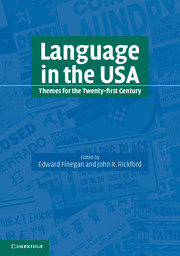Book contents
- Frontmatter
- Contents
- List of figures
- List of tables
- List of contributors
- Acknowledgments
- Foreword
- Editors' preface
- Part 1 American English
- Part 2 Other language varieties
- Part 3 The sociolinguistic situation
- 15 Language ideology and language prejudice
- 16 Ebonics and its controversy
- 17 Language planning, language policy, and the English-Only Movement
- 18 Language in education
- 19 Adolescent language
- 20 Slang
- 21 Hip Hop Nation Language
- 22 Language, gender, and sexuality
- 23 Linguistic identity and community in American literature
- 24 The language of doctors and patients
- 25 The language of cyberspace
- 26 Language attitudes to speech
- Index
17 - Language planning, language policy, and the English-Only Movement
Published online by Cambridge University Press: 05 June 2012
- Frontmatter
- Contents
- List of figures
- List of tables
- List of contributors
- Acknowledgments
- Foreword
- Editors' preface
- Part 1 American English
- Part 2 Other language varieties
- Part 3 The sociolinguistic situation
- 15 Language ideology and language prejudice
- 16 Ebonics and its controversy
- 17 Language planning, language policy, and the English-Only Movement
- 18 Language in education
- 19 Adolescent language
- 20 Slang
- 21 Hip Hop Nation Language
- 22 Language, gender, and sexuality
- 23 Linguistic identity and community in American literature
- 24 The language of doctors and patients
- 25 The language of cyberspace
- 26 Language attitudes to speech
- Index
Summary
Editors' introduction
This chapter will capture the interest of many readers because of its detailed discussion of recent, controversial voter initiatives restricting bilingual education in California (Proposition 227) and Arizona (Proposition 203). But these developments are historically situated in the emergence of the English-Only Movement of the 1980s and its opposition, the English-Plus alternative. The English-Only Movement in turn is contextualized in a much older ideology of English monolingualism in the USA, in favor of which arguments including antighettoization and national unity have been amassed.
Terrence Wiley precedes and intersperses his discussion of English monolingualism and the current English-Only and English-Plus movements with a general introduction to language planning and policy. He distinguishes among corpus planning, status planning, and acquisition planning, and classifies language policies according to whether they are promotion oriented, expediency oriented, tolerance oriented, restriction oriented, or repression oriented.
Wiley reminds us that issues of language policy and planning ultimately involve the influence and control of social behavior, and he challenges what he sees as the “philistine logic of conquer or be conquered” underlying the ideology of monolingualism. He closes with a series of questions for us to consider, including the extent to which other languages can be allowed to coexist and even benefit US society as a whole at the same time that the influence of English expands. This and similar questions are not just about languages, but about their speakers, and their rights, statuses, advantages, and disadvantages.
- Type
- Chapter
- Information
- Language in the USAThemes for the Twenty-first Century, pp. 319 - 338Publisher: Cambridge University PressPrint publication year: 2004
- 28
- Cited by

